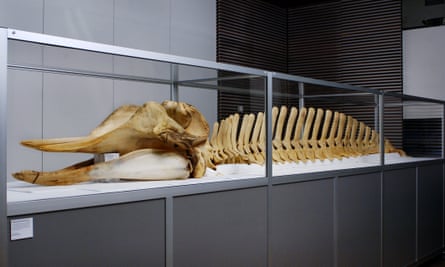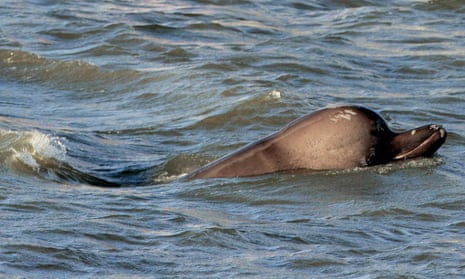Sitting in a glass case are the bones of the Thames whale. They lie arrayed in sad splendour; the great eyeless skull, the mountain range of vertebrae, the delicate bones of the flippers. And, at the tail of the whale, there’s a little bottle containing oil from its bones. Carefully stoppered, it resembles nothing so much as a collection of the creature’s tears.
Ten years ago next week, on 20 January 2006, the whale – a northern bottlenose – swam up the Thames and created a sensation. As the drama played out over the next two days, the world’s media assembled along the banks of the river, or hovered overhead. For the first time since Winston Churchill’s funeral, the waterway was closed. A strange kind of mass hysteria came over London, and the country. This one animal was so well-tracked it might have been the last of its kind. As Richard Sabin, of the Natural History Museum, noted so astutely, she had become a “personality animal”, one invested with our human longings. Sabin, looking back over the story, in which he played a key role, still finds the event “very moving”.

This Thursday, the whale is to be commemorated by a march from the Natural History Museum to the Battersea park beach where she was stranded. In eccentric British fashion, the march will feature the Whale Song Orchestra, playing a computer-generated threnody to the whale while balancing their speakers on a bicycle, and contributions from puppeteers and the Royal Academician Bob and Roberta Smith. “The Thames whale brought Londoners together in support of nature,” says Liam Geary Baulch, one of the artists organising the event. “Ten years on, we wanted to celebrate it and help its memory survive. We know the whale was important to many people.”
The plight of the Thames whale, like other stranded whales,, seemed to speak to the disconnection between ourselves and the natural world. Appearing in central London, it represented an antidote to our sense of remorseless dominion. The story has passed into a kind of legend. Michael Morpurgo wove it into a plaintive children’s book, This Morning I Met a Whale; Damon Albarn sang an elegy, Northern Whale. This year, too, the whale will be celebrated in a film installation by Jessica Sarah Rinland as part of the forthcoming Utopia season at Somerset House.
Those bones were originally housed in the Guardian’s temporary exhibition space in Clerkenwell in 2007, on the first anniversary of her death. Visitors queued to view her as if venerating the relics of a cetacean saint. Was it an art installation – the case was constructed by the company who designed the tank for Damien Hirst’s pickled shark – or a symbol of a world in which all nature might end up under glass? Whatever, this week’s march will pay tribute to an animal that became, and remains, more than the sum of its parts.

Comments (…)
Sign in or create your Guardian account to join the discussion